To use create a dialog, import it first:
from notipy_osx import dialog_prompt
Parameters
text (string), buttons (list, strings), default_button (string), cancel_button (string), password, (boolean), icon (string).
text, string (required)
The text on the dialog.
dialog_prompt(text='Hello')
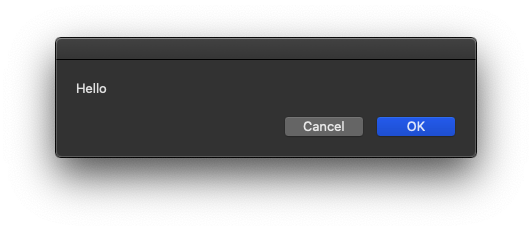
buttons, list of strings
The buttons to show below the text (or the user input). By default AppleScript puts the "Cancel" and "OK" buttons. These can be customized:
dialog_prompt(
text='Buttons example',
buttons=['Second', 'First']
)
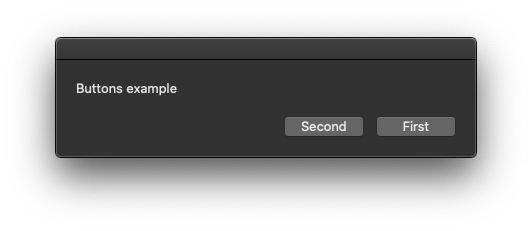
Maximum 3 buttons are allowed.
These buttons can be used to take user input.
default_button, string
The button that is highlighted blue and actived when the "return" key is pressed.
For example, we can set the button "First" as the default button:
dialog_prompt(
text='Buttons example',
buttons=['Second', 'First'],
default_button='First'
)
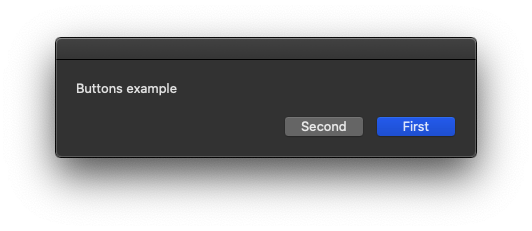
The string you put as the default_button has to be in the buttons list.
cancel_button, string
The button that "cancels" the dialog. When a cancel_button is pressed, the dialog can be closed when the user hits the "escape" key.
If the parameter buttons contains the string "Cancel", it is set as the cancel_button by default. We can also explicitly set the cancel button.
dialog_prompt(
text='Buttons example',
buttons=['Second', 'First'],
default_button='First',
cancel_button='Second'
)
There are no visual changes, but the user can now use the "escape" key to close the dialog.
default_answer, string
The default text input. When default_answer is set to an empty string, the text input is shown.
dialog_prompt(
text='Text input example',
default_answer=''
)
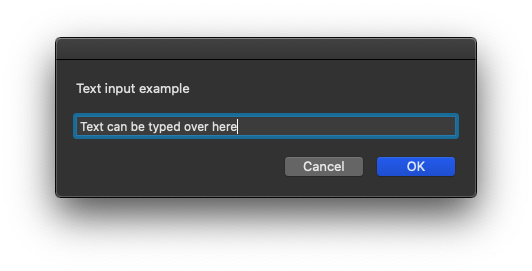
This text field can take user input.
password, boolean
Whether to use a password field (with hidden text). password defaults to False.
Note that setting password to True has no effect unless default_answer is specified.
dialog_prompt(
text='Text input example',
default_answer='',
password=True
)
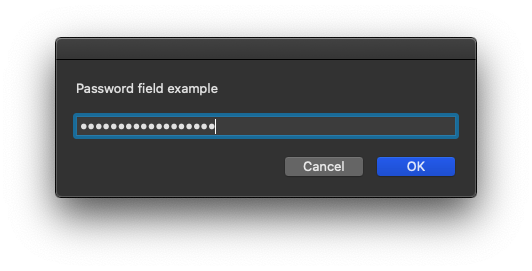
icon, string
The icon to show at the left side. By default, no icon is shown.
You may either provide a relative path to an icon, or use one of the three predefined icons from AppleScript (note, caution, or stop)

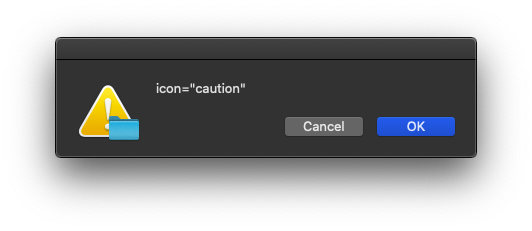
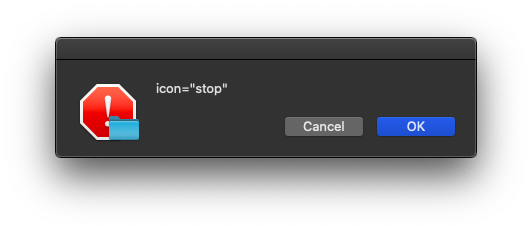
If you have an icon (Terminal.icns, for example), you can specify the relative path:
prompt = dialog_prompt(
text='notipy_osx',
buttons=['Install', 'Star'],
default_button='Star',
# relative path
icon='icons/Terminal.icns'
)
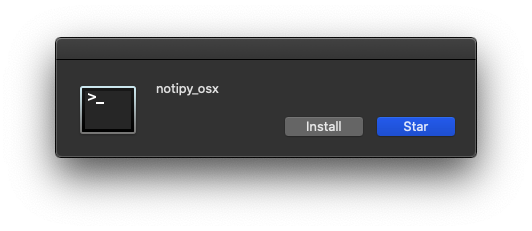
User input
the function dialog_prompt returns a Result object which contains the properties button_returned and text_returned.
Buttons
The return value of dialog_prompt. will always contain button_returned. For example,
answer = dialog_prompt(
text='Buttons example',
buttons=['Second', 'First']
)
print(answer.button_returned)
# prints either "Second" or "First"
With the above code, pressing the "return" key does not do anything. When a default_button is set, the "return" key pressed that button automatically.
answer = dialog_prompt(
text='Buttons example',
buttons=['Second', 'First'],
default_button='First'
)
print(answer.button_returned)
# prints 'First' if the "return" key is pressed
Text
The return value of dialog_prompt. will contain button_returned if default_set is specified. For example,
answer = dialog_prompt(
text='Buttons example',
buttons=['Second', 'First'],
default_button='First',
# specify default_answer for the text field to show
default_answer=''
)
print(answer.text_returned)
# prints the text you type in the text field
dialog_prompt can return both text and button pressed.
answer = dialog_prompt(
text='Buttons example',
buttons=['Second', 'First'],
default_answer=''
)
print(answer.text_returned)
print(answer.button_returned)
The same applies with password is set to True.